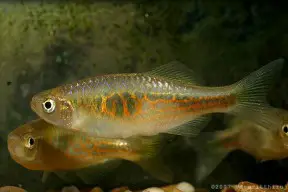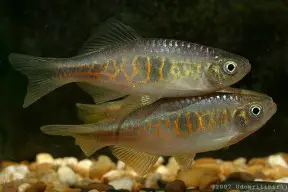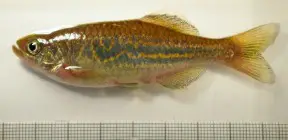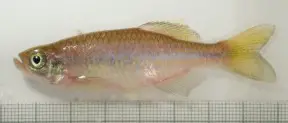Devario sp. 'giraffe'
Etymology
Devario: appears to be derived from a local vernacular name for the type species of the genus Cyprinus (now Devario) devario Hamilton, 1822.
Classification
Order: Cypriniformes Family: Cyprinidae
Distribution
Unclear but known to be collected in Myanmar with no additional details available at present.
Maximum Standard Length
At least 80 mm.
Aquarium SizeTop ↑
An aquarium with surface dimensions of 120 ∗ 30 cm or equivalent should be the smallest considered.
Maintenance
Likely to fare best in an aquarium set up to resemble a flowing stream or river with a substrate of variably-sized, water-worn rocks, sand, fine gravel and perhaps some small boulders.
This can be further furnished with driftwood roots or branches, and while the majority of aquatic plants will fail to thrive in such surroundings hardy types such as Microsorum, Bolbitis or Anubias spp. can be grown attached to the décor.
Since it naturally occurs in pristine habitats it’s probably intolerant to accumulation of organic pollutants and requires more-or-less spotless water in order to thrive.
Though very fast flow is unnecessary it should also prefer a relatively high proportion of dissolved oxygen and moderate water movement.
Weekly water changes of 30-50% volume should be considered routine, and the tank must have a very tightly-fitting cover as all Devario spp. are accomplished jumpers.
Water Conditions
Temperature: 18 – 26 °C
pH: 6.0 – 8.0
Hardness: 36 – 268 ppm
Diet
Almost certain to prey chiefly on insects and their larvae in nature although in the aquarium it’s a largely unfussy feeder and will accept most foods.
A good quality dried product can be used as the staple diet but this should be supplemented with regular meals of small live and frozen fare such as bloodworm, Daphnia, Artemia, etc., for the best colouration and conditioning.
Behaviour and CompatibilityTop ↑
Not an aggressive fish but may upset slow-moving or timid tankmates with its constant activity and vigorous feeding behaviour, and is therefore most appropriate for larger aquaria containing robust, similarly-sized fishes.
There are plenty of suitable choices including many cyprinids, loaches, cichlids, catfishes and characins, although as always when selecting a compatible community of fish proper research is essential.
It’s a schooling species by nature and ideally should be kept in a group of at least 8-10 specimens which will not only make the fish less nervous but will result in a more effective, natural looking display.
Any aggression will also be contained as the fish concentrate on maintaining their hierarchical position within the group, and males tend to display better colours in the presence of rivals.
Sexual Dimorphism
Sexually mature females should be rounder-bellied, less colourful and a little larger than males.
NotesTop ↑
This unidentified species was first collected in 2007 but very little is known about it.
The vernacular name refers to the colour pattern on the body which resembles that of a giraffe.
Specimens examined by Collins et al. (2012) possessed the following characters: two pairs of very small barbels; infraorbital process IO1 present; deep, bulky body shape; lateral line complete with 31-34 pored scales; 9½-11½ branched dorsal rays; 12½-14½ branched anal-fin rays; 14-15 predorsal scales; cleithral spot not distinct; P-stripes and interspaces broken up anteriorly into spots, rings and vertical bars.
In recent years it’s become commonplace to refer to the stripes on the body and fins of danionins as follows:
– P stripe: or ‘pigment stripe’ is the central, dark, lateral stripe on the body which extends into the caudal-fin in some species. Stripes above it are numbered P+1, P+2, etc., and those beneath P-1, P-2, P-3.
– A stripe: the central stripe on the anal-fin; the proximal stripe (above it) is A+1 and the distal stripe (beneath) A-1.
– D stripe: The submarginal dorsal-fin stripe.
Following Fang (2003) Devario spp. are characterised by: possession of a P stripe extending onto the median caudal-fin rays; a short maxillary barbel (absent in some species); absence of the A stripe (a less distinct, relatively wide stripe is present in some species, e.g., D. acrostomus, D. annandalei, D. xyrops); a short, wide premaxillary process (cleft in the upper jaw) with a tiny apophysis (bony tubercule) touching the kinethmoid bone; infraorbital 5 not or slightly reduced.
The current genus name has only been in general use since 2003 prior to which members were considered to belong to the genus Danio.
Older, molecular, phylogenies tended to agree that the latter represented a monophyletic group consisting of two major clades; the ‘Danio devario‘ group containing the larger, deeper-bodied species and the ‘D. rerio‘ clade comprising the smaller, slimmer fish.
The currently invalid genus name ‘Brachydanio‘ was often adopted for members of the latter group and is seen in much of the older aquarium literature.
However in 2003 Fang conducted a more detailed study based on morphological characters which included members of other related genera, and the results suggested for the first time that the genus Danio as previously considered represents a polyphyletic grouping, i.e., not all members derived from a single common ancestor.
The genus name Devario was suggested for the larger species with Danio being applied only to the smaller fish, although following Kottelat (2013) the latter should be used only for the type species, Danio dangila, with most former members placed within the revalidated genera Brachydanio and Celestichthys.
These results have largely been supported by subsequent phylogenetic analyses (e.g. Mayden et al., 2007), although Devario has still undergone a little reshuffling, particularly following Fang et al. (2009) and Kottelat (2013).
In the former study the two species previously comprising the genus Inlecypris were brought into synonymy with Devario and three species formerly included in Microrasbora were moved into the new genus Microdevario based on possession of shared synapomorphies with Devario. The existence of a monophyletic clade consisting of the genera Devario, Chela, Laubuca, Microdevario and Microrasbora was also hypothesised, a theory upheld in the more recent study by Tang et al. (2010). The genus Betadevario (Pramod et al., 2010) is also nested within this grouping and is sister to Devario and Microrasbora.
Kottelat (2013) revalidated the genus Inlecypris whilst noting that phylogenetic evidence suggests the existence of two genetic lineages within Devario. The first contains the species with prominent lateral stripes, which leaves the remaining members (D. apogon and D. chrysotaeniatus) of uncertain taxonomic placement. In addition, a number of the striped species share a colour pattern comprising a midlateral stripe on the posterior half of the body with a few bars in the anterior portion and golden patches between them. These may eventually be placed in a separate genus for which the name Parabarilius is available.
Within the family Cyprinidae the ‘Devario clade’ is most closely-related to a ‘Danio clade’ containing the genera Danio and Danionella plus an ‘Esomus clade’ which groups Esomus alongside Paedocypris and Sundadanio. Closer relationships within Devario itself require further research, however.
References
- Collins R. A., K. F. Armstrong, R. Meier, Y. Yi, S. D. J. Brown, R. H. Cruickshank, S. Keeling, and C. Johnston, 2012 - PLoS ONE 7(1): e28381
Barcoding and border biosecurity: identifying cyprinid fishes in the aquarium trade. - Cottle, P. W., 2010 - NPM Publishing: 1-160
Danios and Devarios. - Fang, F., 2003 - Copeia 2003(4): 714-728
Phylogenetic Analysis of the Asian Cyprinid Genus Danio (Teleostei, Cyprinidae). - Fang, F., M. Norén, T. Y. Liao, M. Källersjö and S. O. Kullander, 2009 - Zoologica Scripta 38(1): 1-20
Molecular phylogenetic interrelationships of the south Asian cyprinid genera Danio, Devario and Microrasbora (Teleostei, Cyprinidae, Danioninae). - Kottelat, M., 2013 - The Raffles Bulletin of Zoology Supplement 27: 1-663
The fishes of the inland waters of southeast Asia: a catalogue and core bibiography of the fishes known to occur in freshwaters, mangroves and estuaries. - Mayden, R. L., K. L. Tang, K. W. Conway, J. Freyhof, S. Chamberlain, M. Haskins, L. Schneider, M. Sudkamp, R. M. Wood, M. Agnew, A. Bufalino, Z. Sulaiman, M. Miya, K. Saitoh, S. He, 2007 - Journal of Experimental Zoology, Molecular Development and Evolution 308B: 642-654
Phylogenetic relationships of Danio within the order Cypriniformes: a framework for comparative and evolutionary studies of a model species. - Pramod, P. K., F. Fang, K. Rema Devi, T.-Y. Liao, T. J. Indra, K. S. Jameela Beevi and S. O. Kullander, 2010 - Zootaxa 2519: 31-47
Betadevario ramachandrani a new danionine genus and species from the Western Ghats of India (Teleostei: Cyprinidae: Danioninae). - Tang, K. L., M. K. Agnew, W. J. Chen., M. V. Hirt, T. Sado, L. M. Schneider, J. Freyhof, Z. Sulaiman, E. Swartz, C. Vidthayanon, M. Miya, K. Saitoh, A. M. Simons, R. M. Wood and R. L. Mayden, 2010 - Molecular Phylogenetics and Evolution 57(1): 189-214
Systematics of the subfamily Danioninae (Teleostei: Cypriniformes: Cyprinidae).







